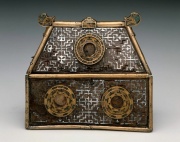Difference between revisions of "Lead alloys"
Jump to navigation
Jump to search
| (One intermediate revision by one other user not shown) | |||
| Line 1: | Line 1: | ||
| − | [[File:52.1396-C31611CR-d1.jpg|thumb|]] | + | [[File:52.1396-C31611CR-d1.jpg|thumb|Lead-tin alloy inlay<br>MFA# 52.1396]] |
== Description == | == Description == | ||
| Line 8: | Line 8: | ||
alliages de plomb (Fr.); Bleilegierungen (Deut.); aleaciones de plomo (Esp.); lood legering (Ned.); ligas de chumbo (Port.) | alliages de plomb (Fr.); Bleilegierungen (Deut.); aleaciones de plomo (Esp.); lood legering (Ned.); ligas de chumbo (Port.) | ||
| − | == | + | == Risks == |
Inhalation and ingestion of lead fumes and dust is very toxic. | Inhalation and ingestion of lead fumes and dust is very toxic. | ||
| − | == | + | ==Resources and Citations== |
* David Matthews, Moldmaking and Casting FAQ, www.sfcmd.com/heavygear/faqs/moldmaking_faq.txt | * David Matthews, Moldmaking and Casting FAQ, www.sfcmd.com/heavygear/faqs/moldmaking_faq.txt | ||
Latest revision as of 09:01, 16 September 2022
Description
Lead alloys well with other metals and is often used in mixtures containing 62-95% Lead, 1-35% Tin, and 3-13% Antimony. Lead alloys melt at 290-390 C to form a medium viscosity liquid. Lead alloys are soft and do not reproduce fine detail well when molded.
Synonyms and Related Terms
alliages de plomb (Fr.); Bleilegierungen (Deut.); aleaciones de plomo (Esp.); lood legering (Ned.); ligas de chumbo (Port.)
Risks
Inhalation and ingestion of lead fumes and dust is very toxic.
Resources and Citations
- David Matthews, Moldmaking and Casting FAQ, www.sfcmd.com/heavygear/faqs/moldmaking_faq.txt
